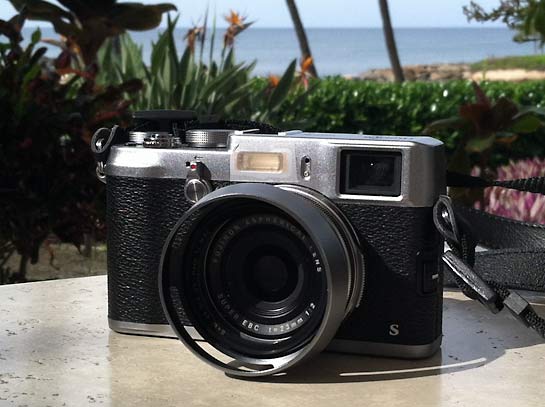
My FujiFilm X100S with optional lens hood and lens filter. And yes, I taped a piece of 1/8 CTO gel over the flash to warm it.
As I vacationed with my family in Hawaii last week, I was testing a new, compact mirrorless camera as an alternative to carrying a heavy DSLR.
If you’re anything like me, lugging around a big camera, plus lenses, on a pleasure trip has become so burdensome that I often end up just leaving it at home and doing without a camera entirely. Which, for a photographer, is a tragic sign that something needs to change.
Last summer I wrote about traveling with just an iPhone as my camera. While that was certainly super-convenient, I found that the camera-phone solution didn’t really meet my needs as a photographer, especially in low light.
So the FujiFilm X100S is my new experiment in lightweight travel. The Fuji is one of a new and rapidly expanding breed of mirrorless cameras that offer image quality similar to a DSLR, in a camera not much larger than a traditional pocket point-and-shoot.
If that sounds too good to be true, well of course, it is. There are always trade-offs in photography, and this is no exception. Below I’ll detail my first impressions of the pros and cons of travel with a small but serious camera.
Size and Sensor
The big selling point of the new mirrorless cameras like the Fuji X series (and the Sony NEX series and similar cameras from Olympus, Panasonic, and others) is the presence of a large image sensor — in the Fuji it’s an APS-C sensor equivalent to those found in crop-sensor DSLR cameras like my Canon 7D.
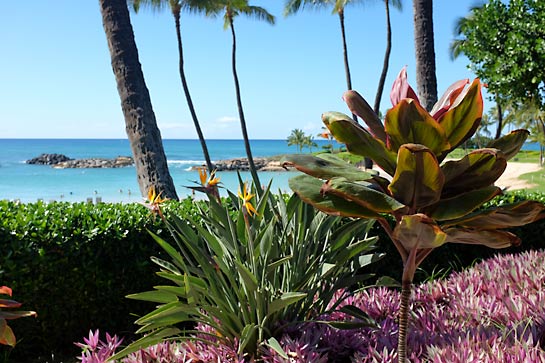
Click to view a 100% crop, and see the detail captured by this sensor.
ISO 200, 23mm, f/8, 1/210 sec
Another popular category of mirrorless cameras is the “micro-four-thirds” group, which have a slightly smaller sensor than the Fuji — but all of these cameras have sensors much larger than the traditional point-and-shoot camera. And because of this large, light-loving sensor, they offer image quality that can rival a DSLR’s.
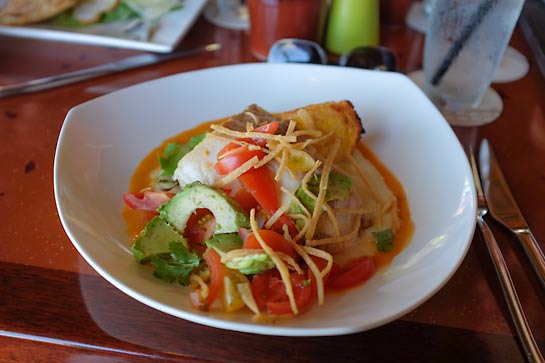
My favorite meal of the trip, a fresh seared Monchong fillet in a tortilla soup base. Click the photo for a 100% crop to see the detail. You can practically taste it!
And by getting rid of the mirror that allows through-the-lens viewing on a DSLR, these new cameras can fit into much more compact bodies. My Fuji is just slightly larger than a pocket point-and-shoot, and I easily carried it on the plane to Hawaii in my briefcase, along with my laptop, iPhone, iPad, books, and other briefcase stuff. No separate camera bag! Hurrah!
In the field, compared to carrying a DSLR with a big zoom lens, the weight of the Fuji feels like nothing. It was a pure pleasure to walk around with this camera. (And I must admit to feeling a touch of smugness as I watched fellow shooters lugging big, heavy DSLR’s in the Hawaii heat while I carried my lightweight, retro-stylish alternative.)
The Fixed Lens Drawback
Based on reviews, I chose the Fuji X100S for its (1) Superb image quality (2) full manual controls, (3) sync-at-any-speed flash control, and (4) a reputation for just being “fun” to handle.
I haven’t fully tested the compatibility with external and remote flashes yet, but I can now confirm that the other three points are accurate. This camera is a ton of fun to carry, and it offers all the manual control any photographer could want.
My greatest worry in choosing the X100S was its fixed 23mm lens (equivalent to 35mm on a full-frame camera.)
I’m a zoom lens kind of guy, especially when traveling, because I love the convenience of carrying one lens (or at most two) that meets all of my needs.
So, I knew that carrying a camera forever locked at a 35mm (equivalent) field of view was sure to be a challenge. But it’s a challenge I chose intentionally, hoping to break myself out of my lazy zoom rut, to go old school, to force myself to move my body around to compose my shots.

The Fuji X100S can’t zoom, but it can focus surprisingly close (without even using the Macro mode) if you’re willing to move yourself into position. ISO 200, 23mm, f/2.0, 1/1000 sec.
Click to enlarge
Of course, not all mirrorless cameras have a fixed lens like the X100S. Some have zoom lenses, and some have interchangeable lenses like a DSLR.
But I already have a shelf full of DSLR’s with interchangeable lenses. I’ve got that need covered. I was looking for a compact, one-piece camera with no extra parts, one that I could put in a briefcase or in the pocket of my cargo shorts, and just go. None of the small cameras with zoom lenses had a reputation for crisp image quality to match the X100S, and the cameras with interchangeable lenses violated my “one piece” rule, thus my choice to experiment with the Fuji and its fixed lens.
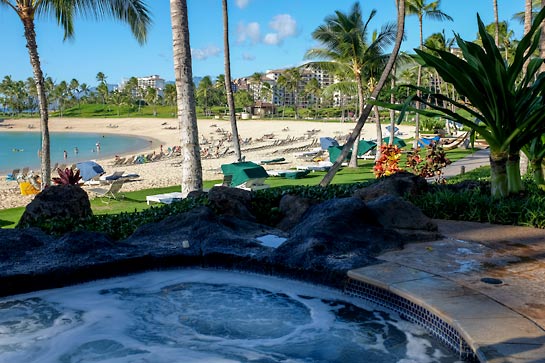
The hot tub with the best view in the world. But I was wishing for a wider lens, to show a more panoramic view. ISO 200, 23mm, f/8, 1/210 sec. Click to enlarge.
And after shooting with the Fuji for a week, I have to say the fixed focal length was less of a frustration than I had anticipated. Sure there were times when I really wished for a wide angle lens to capture the spectacular Hawaiian scenery. And times when I really wished I could zoom in for a portrait. But about 80% of the time I was content to think like a street photographer and work with with the field of view that Fuji gave me.
And that’s the key. With a camera like this, you are a street photographer, a documentary photographer. This is definitely not a portrait camera, but you can take decent environmental portraits if you keep your subject in the center of the frame and don’t get too close, to avoid distortion.
A Low Light Miracle — With Quirks
One of the best features of the X100S is its sensitivity in low light. I could shoot hand-held at 3200 ISO with no flash in dim light and get perfectly usable photos.
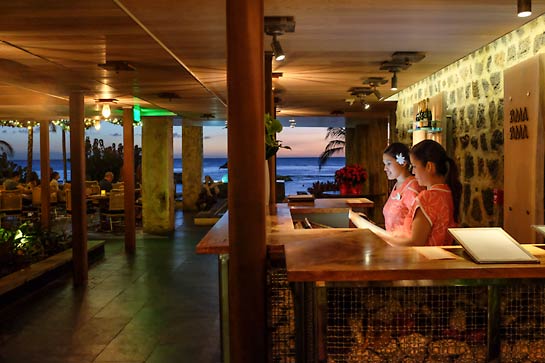
Hand-held at ISO 3200, 23mm, f/5.6, 1/4 sec. Using a post to help stabilize the camera. I could have opened it up 3 more stops if needed. Click to enlarge.
The large sensor and Fuji’s image-processing wizardry create beautiful results. The only camera I’ve ever used with better low-light response is the Canon 5D Mark III, which is a beast to carry by comparison.
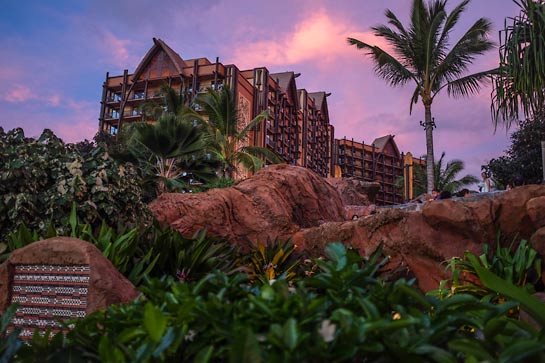
Hand-held at twilight. ISO 800, 23mm, f/2.0, 1/350 sec. Click the photo to enlarge, or click here for a 100% zoom to see the relatively low noise at 800 ISO.
Despite its awesome performance in ambient low light, the X100S lost some points with me for its weak and quirky built-in flash. My flash photos were often over lit, or under lit, and the flash exposure compensation range of -2/3 to +2/3 stop is insufficient control. And don’t even get me started on the way the lens hood blocks the flash. (I only remembered to remove the hood after ruining several shots *each time* I used the flash).
Also, the autofocus has some occasional quirks, too.
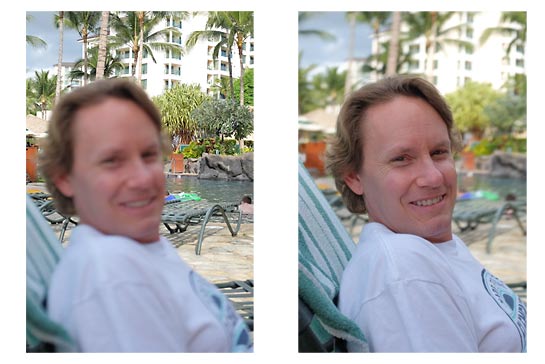
Far too many shots (like the one at left) miss the focus on the subject, especially when you hand the camera to someone else to take a photo. Click to enlarge
Sometimes I just could not get the camera to focus on my subject instead of the background, despite centering the focus rectangle on my subject. Ironically, this happened most often with portraits where the X100S displayed a “Face Detected” label on the photo in playback, as it did on the photo above at left.
So, if face detection is not helping the camera lock focus on faces, then what exactly is it for? (I looked this up later and found that Face Detection on the X100S appears in playback to help you locate and tag photos that have faces, but it does nothing at all help you focus when taking the shot! Many far less expensive cameras have this feature, so this is a major blunder by Fuji in my opinion. They should add it, and let photographers who don’t want the feature turn it off.)
Multiple Points of View
For a small camera, the X100S abounds in viewfinders, offering essentially three. There’s the typical rear LCD screen found on most point-and-shoots. But the real joy for me was using the hybrid optical/electronic viewfinder. (Which works far better for people with a dominant right eye. Lefties will find it awkward with their nose pressed against the LCD). I love that viewfinder, especially its ability to zoom in on your subject, and to use “focus peaking” to aid in manual focus.
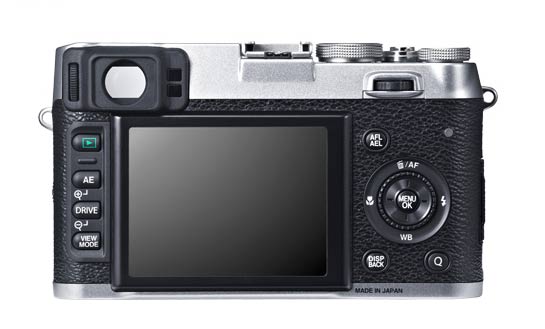
The hybrid viewfinder (top left) is my favorite feature. A convenient switch near your shutter finger toggles between optical and electronic view modes.
The manual focus assist features on this camera are so great that they almost make up for the quirky autofocus — almost. But glorious manual focus is only useful if you like to focus manually. I prefer not to, most of the time, so the autofocus quirks are a real strike against this camera. (If Fuji enabled face-detection autofocus with a firmware upgrade, the camera would become twice as usable.)
Summary
PRO
- Small and light. A joy to hold
- Superb image quality
- Extensive manual control and customization
- Great low light performance
- Ability to control remote flashes and sync at any speed
- Fun retro Leica look
CON
- Fixed 23mm (35mm equivalent) field of view
- Quirky autofocus (and no face detection)
- Quirky built-in flash
- Poor battery life (buy extras)
- Steep learning curve
For me, this was an experiment to answer the question: Can I leave the heavy DSLR at home and travel with a small, fixed-lens camera, while still getting the creative satisfaction I need as a photographer?
The answer was a resounding yes. The great image quality, full manual control, and extensive, customizable functions of the X100S make it a true photographer’s camera. You can get as creative as you want with this thing.
The downside to all that manual control is that it’s not as quick or as foolproof as a traditional point-and-shoot camera. This is not a camera you can hand off to someone else to take your picture. After a while I just stopped trying, because the photos were always out of focus. This is a camera with a learning curve and some quirks to it.
Will it replace your DSLR?
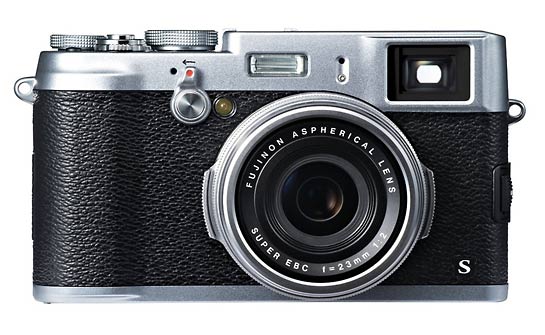 Can you get by with just a camera like the FujuFilm X100S? Not unless you’re a street photographer. This will never be a portrait camera, and the fixed lens is just too limiting for most professional work.
Can you get by with just a camera like the FujuFilm X100S? Not unless you’re a street photographer. This will never be a portrait camera, and the fixed lens is just too limiting for most professional work.
But it just might replace your DSLR as your travel camera, when you want to pack light and still be able to take high-quality photos.
And it might serve as a great backup or second camera to your DSLR in any kind of shooting situation.
Personally, I’m still not sure whether the X100S will become my main travel camera, or whether I’ll succumb to the need for interchangeable lenses (like the Sony NEX-6) or for image stabilization (like the Olympus OM-D E-M5).
But this experiment has convinced me that mirrorless cameras are here to stay, and that one of them will probably be my main travel camera in the future.
If you’re looking for a holiday gift for a special photographer on your list, the X100S might be just the ticket, if that person (a) is a bit of a technical camera geek who likes manual control, and (b) has started leaving the DSLR at home because it’s just too much trouble to carry.
If you decide to buy the X100S I recommend watching David Hobby’s 40-minute video walkthrough of its features. (Also his blog review covers many additional features I didn’t mention. This camera has a lot of features!)
Check the current price on Amazon.com
Price the Fuji X100S on Amazon.com
Optional Equipment that I added to mine
B+W 49mm Clear UV Haze Filter (to protect the lens)
JX100 Lens Hood/Adapter Ring (buy this for $14 or the Fuji version for $90)
As always, if you shop from my Amazon affiliate links you buy me a beer!
———————-
Update June 2014: See my updated review after shooting with this camera for six months: Fuji X100S – A Second Look
———————-
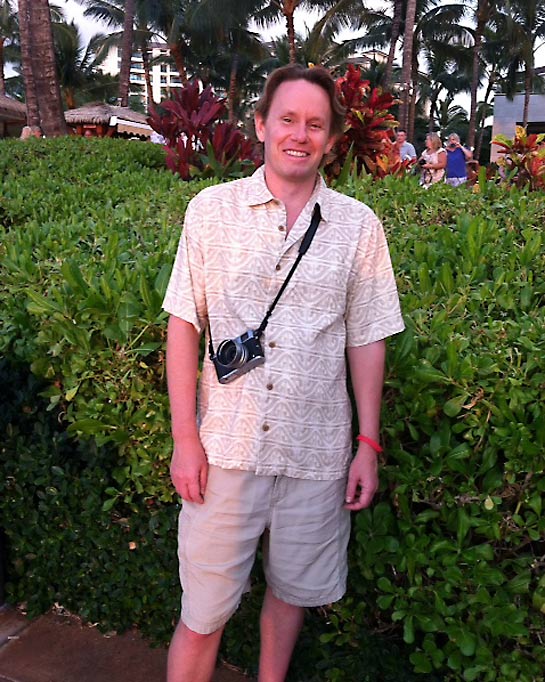



What a coincidence. I just got back from my vacation where I left my 5D MkIII at home and took my Fuji XPro-1. I was a bit nervous about not having the 5D but the Fuji performed great. I invested in the Fuji system because I wanted a good travel set up where I wasn’t hauling around a bunch of heavy gear and having everyone within a 2 block radius notice me every time I brought the camera up to shoot. I’ve had a few months to learn the quirks of the Fuji focusing and I didn’t have any problems. The results were great. In this set, all but 1 picture are from the Fuji. I took my Canon GX1 as a backup but rarely used it.
http://www.flickr.com/photos/johnnyg_photo/sets/72157638705066483/
I think the Fuji’s are fantastic for travel photography and street photography too once you master the focusing.
Thanks John. Any tips on getting the autofocus to nail the spot I want?
Phil, I agree with John. Try the Fuji x-pro1. After 19 years, I bagged the DSLR. In truth, the glass is not equivalent to the L series, but it’s worth a try if you wish to lighten the load and not compromise a good portion of quality. Kerri
If you have only one lens and you need a wider shot, stitching is an option.
When I bought my 60D, I only bought one lens: A 70-200mm (I think I bought it because Phil recommends it in his flash photography course). I wanted to do mainly portraits, and it’s a terrific lens for that purpose. For landscape, not so good. So in those situations, since I only had that one lens, I would simply take several overlapping shots, covering the field of vision I wanted to capture.
It’s not optimal. You need to take a lot of photos for one scene, which takes time. You have to use software to stitch the final image together on the computer, which is extra work in postproduction. And you also need to learn to rotate the camera without changing the perspective.
Ali,
D’oh! Great idea. It never even occurred to me to stitch a panorama for wide angle. The newer Photoshop versions make it pretty easy. Thanks for reminding me.
Where is that hot tub?
Good to see that you enjoyed the freedom,from having to carry DSLR’s.
Owing to a back & neck injury I thought my shooting days were over,then 4/3 came on the market,they joy of being able to carry a camera & a full compliment of lenses,is positively liberating.
Happy Christmas to all out there.
Thank you for the great courses.
I did it too! Succombed to the NEX-6 and after a week long love/hate thing (because I was getting used to it) and being separated from my beloved Nikon D7000, I will not be parted from my Sony! Freedom!
It came with 16-55mm zoom, which is nice, but I notice occasional vignetting. I also have the 55-210mm LOVE IT, and the Sigma 30mm 2.8, which is super sharp. I can fit all this into a Lowepro Passport Sling, with room to spare! I am seriously considering selling my Nikon, something I thought I would never do.
It must be something in the air. I just acquired a used Leica D-Lux 4 for street photography. It is a pleasure to take on trips through the city, woods, or countryside because it is light and takes reasonably good pictures. No, I am not giving up my Canon SLR, but will leave it home on my next annual trip to the UK.
Phil, thank you for publishing road test of Fuji compact. I would be interested in knowing how you think it compares with what is probably its chief rival, the Nikon Coolpix A. One consumer magazine review did a comparo and gave nod to Nikon, mainly for better optics and use of use.
Hi Phil interesting read I also have just gone mirror less and looked at all the options before going for the Olympus OMD EM5. No regrets so far an amazing pocket rocket of a camera which comes with some great zooms. I have got the 12-50 kit lens with the camera which for a kit lens is superb. Has a 2:1 micro mode and is fully weather sealed. Although a f3.5 – 6.3 in good light it is a great lens for the money. However I really want to build a system of lenses and to start with I picked up a Panasonic 20mm (40mm equiv) so similar to your Fuji lens f1.7. This is a superb very small pancake lens with excellent image quality and great reviews everywhere you go. Add to this the EM5 super fast auto focus and 5 way in body image stabilization and this is a winner for me. The camera is so easy to operate very customizable and for £630 with the kit lens (still £950 on Amazon) it ticks all the boxes. Would be interested in your view of this or the EM1 if you ever want to give it a run out. My EM5 goes everywhere with me now which could not be said for the D7000. With the adage the best camera is the one you have with you mirror less is the one with me. Oh and did I mention its put the fun back into taking pictures…cheers mate as they say here in the UK. And Merry Christmas!
The quirky AF issue is the reason, i had to give up on X100 last year. Sold it 3 months later.
Sad to see the AF inconsistency issue still exists! Thanks Phil for writing about it, a lots of other reviews dont really mention it and even if they do, they just take it as a minor issue.
For me, there is nothing i hate more than a shot when I put the green AF rectangle on the people and the camera decides to focus on the trees way behind the the subject.
Will buy it when they actually put face detect AF in newer version of this camera or if they make a firmware that can do it.
Ujwal,
Thanks for your input. From people who owned both versions, I had read and heard that the AF issues in the X100 were fully solved in the X100S. Apparently not fully solved! I’ve only been using it for a week, so I hope that I will discover the secret to getting 100% reliable focus. I must say that its focus is tack sharp when it focuses on the right thing, and I love that sharpness and image quality.
So interested in your experience…I’ve been considering the jump to mirrorless more and more. I recently rented the Olympus OM-D E-M5, with 2 extra lenses for 10 days to see if I could get used to NOT having my big gear with me. For the most part I loved it…loved the small size, and of course…LOVED that I could still have interchangeable lenses (I a zoom girl all the way…can’t deal with fixed much), but I was less than enthused by the lack of sharpness of some of the images I took with it. I guess I still want “near DSLR” quality, and I wasn’t convinced that the Oly would do that. Next rental: Fuji XPro!
use a step-down 49-28mm converter as hood. and make sure you select average metering and manual iso when using the flash to get consistent results.
In March of this year, I had the opportunity to try the Nikon Mirrorless version. I was inspired by the light weight. When I returned home and started to research cameras, I found the Canon SL1 DSLR and looked no further. For me the light weight and DSLR features convinced me to get one. For me a great choice.
Great review, Phil! I’ve had a Fuji X100 for almost a year now and it’s a very impressive camera. Yeah, it has its quirks and takes a bit getting used to them but, overall, I love the camera. As you know, I’m a portrait photographer. I shoot most of my stuff with a Canon 5D using a variety of lenses. But I’m thinking that when it comes time for me to purchase my next “work” camera, it’s going to be a Fuji X series mirrorless with interchangeable lenses. BTW, I’ve shot with my Fuji x100 with a pocket wizard on top triggering studio strobes and the results were excellent! Next, I plan to shoot some high-speed sync stuff with it, probably at shutter speeds way beyond what my 5D can do and see how that works.
@JimmyD — Thanks for chipping in. I’m also really eager to try some off-camera flash with the Fuji at outrageous shutter speeds. And with the built-in ND filter to allow a wide aperture in sunlight. All kinds of potential there!
Hi! Phil must be catching I to-owing to a shoulder
Replacement have gone from a DSLR to the Panasonic
GX7 Mirrorless, small,lightweight ton of features (still
Learning) tack sharp images I think I am converted!!!!!
Regards David.
Hi Phil,
Thanks for the great info. I wanted something light to carry so recently bought a Sony DSC RX-100 which is light and easy to use and the pics are great but has no viewfinder or manual mode so now realise I should have gone with something similar to the camera you reviewed. Novice nelly!! Will look again when the changes are made to the model you reviewed
Hi Phil,
Thanks for your review. I found a love affair with my X-E1 which is at least as good as my photography skills and is a wonderfuly light travelling companion.
Of course with 3 great lens (18-55, 55-200 and 14mm) it gets havier, but even these are smaller and lighter than a Canon or Nikon would provide.
I think regardless of Brand we all can agree that though we have gained so much in technology we have lost something of just loving to photograph. Everything got bigger, heavier and photographers who use such great cameras as the Canon mark 2 and 3 stick out in the crowd and make everyone so much more self-concious. Hence my gratitude to the fuji quality and size. Agreed there is always a trade-off but if anyone wishes to check the results, i have just produced a Blurb book and you just click on the book for preview (preferably on full screen):
http://blur.by/1dpcM3w
For my wife I bought the fuji X20 which is a very small and light camera (with zoom) and the results are great for what she wishes to do.
Thank you again, and let us all just enjoy shooting,
uri Schwartz
My Canon 6D and a big lens was getting to be too much to carry around. So I have just this week sold the whole kit (including 4 good lenses). This was a big move for me but I was encouraged by the ease with which I could use the Sony NEX-6 I bought some months ago with a Zeiss 32mm f1.8 Touit lens. This pairing is perfect (if you are prepared to use only primes). As a result of this successful experiment I have used my Canon sale proceeds to buy a Sony A7 with a Zeiss 55mm f1.8. This is a full-frame camera and the lenses are interchangeable (but don’t forget the crop-factor – on the NEX-6 the 55mm becomes a 90mm). One can use old lenses with suitable adapters – which I do. When the camera goes out, it does so with only one lens. The kit is so light that I can take it all and so cover most eventualities. All I now need is a way of getting iPhoto and Lightroom to read the Sony A7 .arw files! Phil: thank you for your large contribution to my happy life as a very amateurish photographer.
Hope you visited Kauai… SR
Phil, my set up for the focusing is to set the rear AE-L/AF-L button to do the focus and the shutter to do the exposure. It works if the focusing is set to manual. I do the same rear button focusing with the Canon 5D Mlll as well. It does take some getting use to but now that I’ve adjusted to it. 99.9% of my focusing is bang on. I use spot focus so whatever I put the spot on is my main focus point. This was a technique I learned when researching the X100 that a fellow explained how to fix the quirks with that camera. It does take practice though.
I don’t own a Fuji, but I purchased a Nikon Coolpix AW100 @ Costco 2 years ago and love it. You are right, lugging around a heavy camera bag loaded with lenses is a killer. This little puppy is light,small and slides into my pocket with ease. I took it to Africa for a month last year and left my SLR @ the hotel most of the time. And last but not least………….it’s waterproof, great underwater shots.
I shoot with an Xpro-1 and have no problems with AF apart from it being slower and obviously not having the tracking abilities of my pro DSLR’s. Spinning the shutter and lens into “A” mode makes it simple to hand to others and missed shots even then are not an issue. Apart from ensuring you set the focus “box” to an appropriate size for your subject and getting it over areas of contrast there are no other tips I can offer.
By all accounts the AF of the X100S should be even better – perhaps there’s an issue with your copy which warrants sending it in with samples of misses so it can be checked.
Since reading your original article Phil I have been looking into Mirrorless cameras.
I have a pro photographer buddy who has a Fuji – 35mm equv, (main camera are Nikon) and a guru I know (hobbyist like me) who uses Canon and has plunged for the EOS-M 18-55mm (not with the intention of lense interchanging but it’s there should it arise).
Thus I am unsure what to do and where to go…
I have a 6D with 16-35 24-70 and 70-200 all f2.8 and EX600 with wireless trigger.
My brains say stick with Canon, but reviews are few and far between..
I have the x100s. I agree with the comments above, and do have issues with out of focus photos. It seems like you get the green box on the subject and the photo is out of focus. It is almost seems like the camera is back focusing. It will give you the green box and before taking the picture goes into a refocusing mode and the photo is out of focus. Sometimes will get the green box and wheen you chimp the photo is out of focus. I would have liked to see face detection built into the software. One think I do not like, and can’t deal with are photos that are out of focus. My son has a Nikon V1, mirrorless, interchangeable lens, no flash, it seems like the camera never takes a photo that is out of focus.
What an awesome, in-depth review. Thank you!
Your photos look amazing. We’re these straight jpgs out of camera or RAW developed? Thanks!
Fiorentino, those were JPG’s. I typically don’t shoot RAW for something like vacation photos, it just takes too much disk space for too little benefit. Some of these were adjusted slightly in Lightroom.
Seeking a similar travel solution, I recently purchased the new Canon Rebel SL1, advertised as the smallest DSLR on the market. I have coupled this with a Canon EFS 15-85 mm zoom. While not as small or as lightweight as the mirrorless arrangement you tested, it is such a joy to travel with a more portable camera with interchangeable lenses (also have the 40 mm pancake lens, which really reduces bulk). As an aside, just completed your Lightroom online course, and I have to say it is the most informative and useful photo editing class I have ever experienced. Look forward to taking your Photoshop class as well. Thank you.
Jeff, thanks for the camera info, and for the kind words on my Lightroom course!
I am in Shanghai right now with a Canon EOS-M. I travel light for work and my Nikon D7200 was just too much. I would have preferred staying in the Nikon family, but that didn’t work. I specifically wanted interchangeable lenses. My biggest problem is you can take a photo by tapping the monitor, which happens regularly as I walk down the street. Never know what photos I will have at the end of the day.
The smaller size and weight is great for travel. The smaller size also allows for being less conspicuous. I take a lot of photos in local markets and I hate to intrude when people are working. The smaller camera let’s me blend into the background better.
Thanks Phil..
I have two hours off today and instead of doing something fun i am trawling the net trying to find a way of getting this x100s to focus on a face….it just wants the background.
Now i shoot a D700 a lot and know a bit about getting things in focus but coming from a coolpix 7100 where i didnt think about focus because it just did it I am finding this really frustrating.
I have ended up with this which is af-s mode and the smallest of green boxes and seem to be getting a bit more success..
Great review..